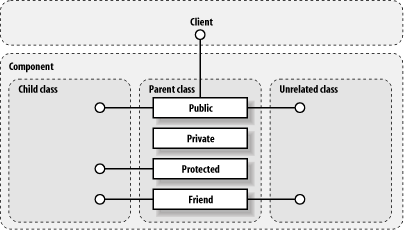3.4. Access Modifiers
Everything that comprises a class is associated with an access modifier that determines the scope or visibility of the entity in question. This is where the art of object design lies. Beyond the semantics of declaring member data and methods, an understanding of these access modifiers is crucial. Each modifier has a few basic guidelines geared toward designing robust, object-oriented code. Figure 3-2 shows the relationships between the four basic modifiers: Public, Private, Protected, and Friend.
Figure 3-2. Access modifier relationships

Public
-
Public classes are visible to everyone and not restricted in any way. Public members are visible inside and outside the class in which they were declared.
Member variables are not typically defined with public scope because this definition would allow unrestricted access to an object's state. In solid OO designs, member variables are kept private.
Private
-
Private classes can only be nested within another class and are completely restricted outside of that scope; it is not possible to declare a standalone class with this modifier. Private classes encapsulate functionality that is specific to the class where they were declared.
Private member variables are accessible only within the current class where they were declared. Even derived classes do not have access to Private members; they can be accessed through ...
Get Object-Oriented Programming with Visual Basic .NET now with the O’Reilly learning platform.
O’Reilly members experience books, live events, courses curated by job role, and more from O’Reilly and nearly 200 top publishers.

